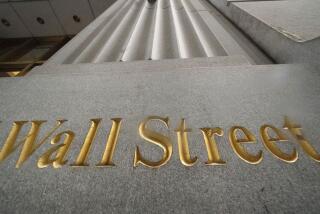Banks borrow less from Fed this week
- Share via
Banks slowed their borrowing from the Federal Reserve this week, the first decline since the credit crisis began this summer. However, the total still was the second-highest since the 2001 terrorist attacks.
A separate report from the central bank showed that the U.S. commercial paper market -- short-term corporate and bank IOUs -- shrank for a sixth week. But the latest decline may be the result of issuers finding better ways to borrow, analysts said.
The Fed said Thursday that average daily bank borrowing from its “discount window” for the week ended Wednesday was $2.18 billion.
That was down from a daily average of $2.93 billion for the week ended Sept. 12, which was the highest since banks borrowed an average of $11.7 billion the week ended Sept. 12, 2001, as the Fed flooded the financial system with money.
The Fed began encouraging banks to use the discount window Aug. 17, when it cut the base lending rate to 5.75% from 6.25% as the global credit crunch deepened and some lenders began to have trouble borrowing normally in financial markets.
The central bank made another cut in its bank loan rate, to 5.25%, on Tuesday, when it also reduced its target for the more important federal funds rate.
Certain sections of the credit markets began to freeze up in midsummer as investors grew fearful about getting repaid. The root of the problem was the surge in defaults on sub-prime mortgage loans, which in turn made investors flee mortgage-backed bonds.
Investor jitters also caused trouble for the commercial paper market, an important source of short-term funding for financial firms and other businesses.
Outstanding commercial paper maturing in 270 days or less fell $48.1 billion in the week ended Wednesday to a seasonally adjusted $1.87 trillion, the Fed said. The total has declined $354.5 billion, or almost 16%, since the week ended Aug. 8.
Interest rates on certain types of commercial paper jumped in August as investors demanded higher returns. But yields have since come down.
Some analysts said the continuing drop in commercial paper outstanding in part showed that some banks and companies have been able to borrow longer-term at favorable rates in recent days -- a sign that the credit crunch is easing.
“There are other funding sources that corporations are able to turn to besides commercial paper,” said Alex Roever, short-term debt strategist at JPMorgan Chase & Co. in New York. “That’s a healthy sign for the overall financial system.”
Financial issuers, in particular, are selling longer-term debt and avoiding the risk that commercial paper won’t roll over when it matures, said James Cusser, a bond fund manager at Waddell & Reed Inc. in Shawnee Mission, Kan.
More to Read
Inside the business of entertainment
The Wide Shot brings you news, analysis and insights on everything from streaming wars to production — and what it all means for the future.
You may occasionally receive promotional content from the Los Angeles Times.










